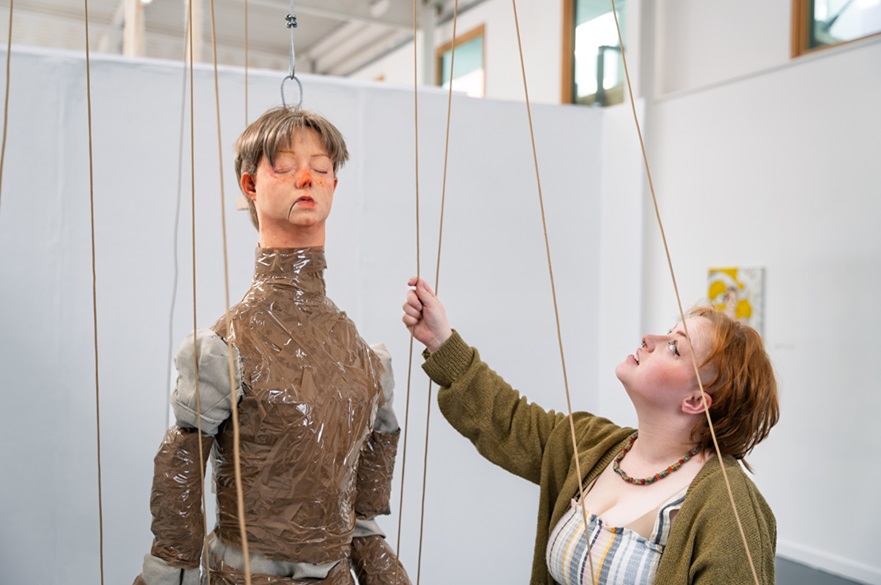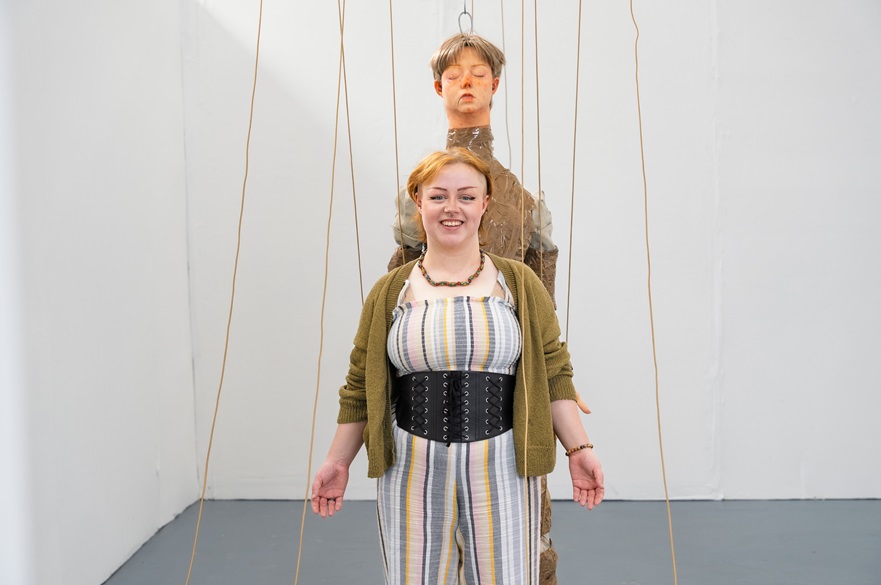Student creates life-size puppet of herself show what it’s like to have Tourette’s
By Chris Birkle | Published on 23 May 2025
Categories: Press office; School of Art & Design;

Student creates life-size puppet of herself show what it’s like to have Tourette’s
Art student Cerys Sleith created a life-size puppet of herself to show people what it’s like to have Tourette’s syndrome.
The 22-year-old, who is studying BA Fine Art at Nottingham Trent University (NTU), wanted people to understand that tics feel like ‘someone else is in control’.
Cerys, who first developed the condition aged 17, hopes to challenge misconceptions about Tourette’s syndrome and make people realise that it’s not just about involuntary swearing.
“In many ways, having Tourette’s can make you feel you’re a puppet. It feels as though someone else is controlling you, and other people can unfortunately laugh,” said Cerys, from Llannerch-y-Medd in Anglesey, Wales.
“Puppets are used for comedy and I wanted to create something interactive and give other people control of me, as a way to communicate how this condition works.
“The involuntary movements make it feel like someone else is pulling at you, and this puppet will hopefully allow others to develop a better appreciation of that loss of control.
“By inviting people interact with this puppet, I hope they may realise that people with Tourette’s can’t control it.”
Cerys’s work is on public display for the 2025 NTU Graduate Showcase, which is one of the largest displays of graduating art and design talent in the UK.
An interview with Cerys
Visitors will be able to interact with the puppet through a rope and pulley system which moves the arms, while an elastic rope system allows the mouth to move.
Small musical instruments which make a sound with movement are embedded inside the arms, legs and jaw to add a comic element.
“When I first developed Tourette’s it was sudden and quite severe,” said Cerys, who studies in the Nottingham School of Art & Design.
“I couldn’t stop moving, I couldn’t eat and was a danger to myself. No one knows what caused it and it’s quite uncommon to develop it in your late teens.
“I was just watching television with a friend and my arm started to twitch. A few days later my mum took me to the doctors and then she said it could be epilepsy, Tourette’s or a brain tumour.
“You have to be continuously ticking vocally for a year until they decide you have it, but only a minority of people experience involuntary swearing.
“My vocal tics were mainly a clicking of the tongue, whistling and saying short bizarre sentences, but because my Tourette’s has calmed down now it’s hardly noticeable. It’s mainly facial tics that I get.
“Many people don’t realise though that people with Tourette's syndrome may also have obsessive compulsive disorder (OCD), attention deficit hyperactivity disorder (ADHD) or learning difficulties, so I wanted to raise awareness of that too.”

Cerys imitating the posture of her artwork puppet
Cerys’s puppet has been crafted from an array of materials. The head is made from silicone and is a cast of Cerys’s own head, so that its face looks just like hers.
The puppet has latex hands and feet and the body – also a cast of Cerys - is stuffed with recycled newspapers, tape, scrap paper and scrap fabric.
The joints are made from offcut fabrics to provide mobility, with wooden blocks and zinc hooks serving as bones and joints to allow for fluid movements.
The puppet contains clackers embedded in the mouth and groan tubes are in the arms.
A video projection displays Cerys’s own eyes onto the puppet’s face to convey the emotions and exhaustion that often accompany the condition.
Fine Art senior lecturer Lisa Selby, of the Nottingham School of Art & Design, said: “Cerys is making a public statement through her art to challenge misconceptions and attitudes towards Tourette’s.
“By interacting with the work, gallery visitors can gain an insight into how people with the condition may feel, which will hopefully allow them to develop a better awareness.”
Notes for Editors
Press enquiries please contact Chris Birkle, Public Relations Manager, on telephone +44 (0)115 848 2310, or via email.
Nottingham Trent University (NTU) has been named UK ‘University of the Year’ five times in six years, (Times Higher Education Awards 2017, The Guardian University Awards 2019, The Times and Sunday Times 2018 and 2023, Whatuni Student Choice Awards 2023) and is consistently one of the top performing modern universities in the UK.
It is the 3rd best modern university in the UK (The Times and Sunday Times Good University Guide 2023). Students have voted NTU 1st in the UK for student employability (Uni Compare 2025)
NTU is the 5th largest UK institution by student numbers, with over 40,000 students and more than 4,400 staff located across six campuses. It has an international student population of almost 7,000 and an NTU community representing over 160 countries.
NTU owns two Queen’s Anniversary Prizes for outstanding achievements in research (2015, 2021). The first recognises NTU’s research on the safety and security of global citizens. The second was awarded for research in science, engineering, arts and humanities to investigate and restore cultural objects, buildings and heritage. The Research Excellence Framework (2021) classed 83% of NTU’s research activity as either world-leading or internationally excellent.
NTU was awarded GOLD in the national 2023 Teaching Excellence Framework (TEF) assessment, as it was in 2019.
NTU is a top 10 for sport (British Universities and Colleges Sport league table 2023).
NTU is the most environmentally sustainable university in the UK and second in the world (UI Green Metric University World Rankings, 2023).